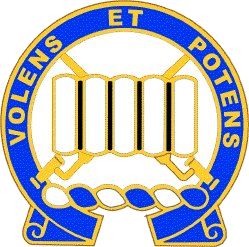
The 3rd Infantry Division is a combined arms division of the United States Army based at Fort Stewart, Georgia. It is a direct subordinate unit of the XVIII Airborne Corps and U.S. Army Forces Command. Its current organization includes a division headquarters and headquarters battalion, two armored brigade combat teams, one National Guard infantry brigade combat team, one task force battalion, one aviation brigade, a division artillery, a sustainment brigade and a combat sustainment support battalion along with a maneuver enhancement brigade. The division has a distinguished history, having seen active service in World War I, World War II, the Korean War, Vietnam War, and the Global War on Terror. The Medal of Honor has been awarded to 61 members of the 3rd Infantry Division, making the division the most honored in the Army.

The 2nd Infantry Division is a formation of the United States Army. Its current primary mission is the pre-emptive defense of South Korea in the event of an invasion from North Korea. There are approximately 17,000 soldiers in the 2nd Infantry Division, with 10,000 of them stationed in South Korea, accounting for about 35% of the United States Forces Korea personnel.

The 7th Infantry Division is an active duty infantry division of the United States Army based at Joint Base Lewis-McChord charged with sustaining the combat readiness of two Stryker brigade combat teams, a combat aviation brigade, a division artillery headquarters, and a National Guard Stryker brigade combat team, as well as participating in several yearly partnered exercises and operations in support of U.S. Army Pacific and the Indo-Pacific region. The 7th Infantry Division is the only active-duty multi-component division headquarters in the Army. The 7th Infantry Division is also home to two of the Army's newest enabling battlefield capabilities, the Multi Domain Task Force and the Intelligence, Information, Cyber, Electronic Warfare and Space Capabilities, or I2CEWS battalion.

The 25th Infantry Division is a United States Army division based at Schofield Barracks in Hawaii. The division, which was activated on 1 October 1941 in Hawaii, conducts military operations primarily in the Asia-Pacific region. Its present deployment is composed of Stryker, light infantry, airborne, and aviation units. Tropic Lightning soldiers serve as the premier Army response force for the U.S. Pacific Command, and regularly train with other U.S. military branches to practice and maintain joint operations capabilities. The climate and terrain of the Pacific region demands Tropic Lightning soldiers be able to operate in physically demanding and harsh environments. In 2014, the division opened the Jungle Operations Training Center—the first such school in the Army since the closing of the old Jungle Warfare School at Fort Sherman, Panama Canal Zone. Joint operations and training with partner states herald a new chapter in the history of Tropic Lightning—America's Pacific Division.

The 40th Infantry Division is a modular division of the United States Army. Following the army's modularization the division has become a four-brigade combat team with National Guardsmen from throughout the Pacific/Western United States and Oceania. Its division headquarters is located at Los Alamitos Joint Forces Training Base in Los Alamitos, California.

The 9th Infantry Regiment ("Manchu") is a parent infantry regiment of the United States Army.
The 9th Engineer Battalion is a unit of the United States Army that deploys to designated contingency areas and conducts combat and/or stability operations in support of a brigade combat team. It is a divisional mechanized combat engineer unit, composed of three line companies and a headquarters company. Its mission is to provide assured mobility, counter-mobility, general engineering, and survivability support, with well trained sappers ready to deploy anywhere at any time. The unit's history spans service in 1917 in the US southwest, World War II in France and Germany, multiple deployments to the Balkans, and multiple deployments in support of the Global War on Terrorism in Iraq and Afghanistan. It is most famous for the capture of the Ludendorff Bridge across the Rhine River. As of 18 May 2015, the battalion exists as the 9th Brigade Engineer Battalion in Fort Stewart, GA under 2nd Armored Brigade Combat Team, 3rd Infantry Division.

The 24th Infantry Regiment is a unit of the United States Army, active from 1869 until 1951, and since 1995. Before its original dissolution in 1951, it was primarily made up of African-American soldiers.

The 14th Infantry Regiment is a United States Army light infantry regiment. It has served in the American Civil War, Boxer Rebellion, World War II, Korean War, Vietnam War, Operation Restore Hope, Operation Uphold Democracy, Operation Joint Guard, Operation Desert Storm, Operation Enduring Freedom, Operation Gothic Serpent, Operation New Dawn, Operation Resolute Support, and Operation Iraqi Freedom. The 14th Infantry Regiment did not take part in combat during World War I. It has also conducted peacekeeping and humanitarian missions in the Sinai Peninsula, Guantánamo Bay in Cuba, Bosnia, and Kosovo.
The 27th Infantry Regiment, nicknamed the "Wolfhounds", is a regiment of the United States Army established in 1901, that served in the Philippine–American War, in the Siberian Intervention after World War I, and as part of the 25th Infantry Division during World War II, the Korean War, and later the Vietnam War. More recently the regiment deployed to Afghanistan for the second time, following two deployments to Iraq. The regimental march is the Wolfhound March.

The 35th Infantry Regiment ("Cacti") was created on 1 July 1916 at Douglas, Arizona from elements of the 11th, 18th and 22nd Infantry Regiments. The 35th served on the Mexico–US border during the First World War and was stationed at Nogales, Arizona in 1918. It fought a border skirmish on 27 August 1918 during the Battle of Ambos Nogales.

The 7th Infantry Regiment is an infantry regiment in the United States Army. In its 200-year history it has participated in 12 wars, been awarded 78 campaign streamers, and 14 unit decorations. The regiment has served in more campaigns than any other infantry unit in the United States Army.

The 20th Infantry Regiment is a United States Army infantry regiment. Currently only the 5th Battalion of the 20th Infantry still exists. Stationed at Joint Base Lewis-McChord and part of the 1st Stryker Brigade Combat Team, 2nd Infantry Division, 5-20 Infantry was one of the original battalions selected to take part in the testing and fielding of the Army's new Stryker vehicle.

The 21st Infantry Regiment ("Gimlet") is a United States Army infantry regiment. The 1st and 3rd Battalions of the 21st currently exist as part of the 25th Infantry Division. The regiment fought in World War II, the Korean War and the Vietnam War, as well as Operation Iraqi Freedom. Task Force Smith, the first American unit to see action in the Korean War, was derived from the regiment's 1st Battalion.
The 32nd Infantry Regiment is a battalion within the United States Army. Of the original regiment, only the 1st Battalion remains as an active duty unit. The 1st Battalion, 32nd Infantry Regiment is a light infantry battalion assigned to the 1st Brigade Combat Team, 10th Mountain Division, garrisoned at Fort Drum, New York. The battalion was previously assigned to the 3rd Brigade Combat Team at Fort Drum, before this unit was reflagged to Fort Polk, Louisiana.
The 64th Armor Regiment is an armor regiment of the United States Army, organized under the United States Army Regimental System. It is descended from the 758th Tank Battalion (Light) that served in the Italian campaign during World War II. Redesignated as the 64th Tank Battalion, it was assigned to the 3rd Infantry Division during the Korean War and it spent most of the Cold War stationed in West Germany before elements were transferred to Ft. Stewart, Georgia in the late 1990s. The regiment participated in Desert Shield, Desert Storm, Desert Fox, Desert Spring, Operation Iraqi Freedom and Operation Enduring Freedom.

The 296th Brigade Support Battalion is a battalion of the United States Army composed of four companies that support the operations of the 1/2 ID SBCT. The companies are Headquarters and Headquarters Company (HHC), Alpha Company, Bravo Company, and Charlie Company.

The 14th Brigade Engineer Battalion is a Combat Engineer Battalion of the United States Army based at Joint Base Lewis-McChord, Washington. The battalion is a subordinate unit of the 2nd Stryker Brigade, 2nd Infantry Division, and I Corps. The battalion's official motto is "Gong Mu Ro" and battle cry "Rugged!".
The 8th Field Artillery Regiment is a field artillery regiment of the United States Army first formed in 1916. The regiment served in World War I, World War II, and Korea, and regimental units have served in Vietnam, Honduras, Panama, Operation Desert Storm, Operation Enduring Freedom and Operation Iraqi Freedom. Currently organized as a parent regiment under the U.S. Army Regimental System, the regiment's only active component is the 2nd Battalion, 8th Field Artillery Regiment, currently assigned to the 1st Stryker Brigade Combat Team, 25th Infantry Division and stationed at Fort Wainwright, Alaska.
The 2nd Battalion, 8th Field Artillery Regiment is the field artillery battalion organic to the 1st Brigade Combat Team, 25th Infantry Division. Originally organized in 1916, the battalion has seen combat service in World War I, World War II, Korea, and the Global War On Terror. Most recently deploying to Iraq in support of Operation Inherent Resolve. The Automatic Battalion has earned, 14 campaign streamers and at least 8 unit awards. The battalion is currently at Fort Wainwright, Alaska.

















